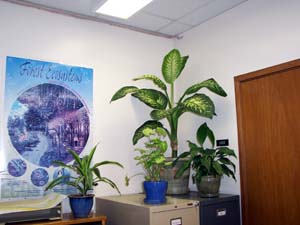
Kent Kobayashi
Tropical Plant & Soil Sciences Dept.
College of Tropical Agriculture & Human Resources
University of Hawaii at Manoa
Benefits. Plants are such a joy to have indoors! They
are attractive, fascinating, and keep us in touch with "nature." Not
only do plants provide us with a psychological lift, they are
beneficial:

Plants can enhance the decor of any office!
Plants
"Clean" Air Inside Our Homes. Laura
Pottorff, Colorado State University.
Although this web site deals with supplemental lighting in the
office, it is also applicable to your home, apartment, or
dormitory.
Location. Ideally, plants should be placed in an indoor
location where they receive some sunlight daily--whether direct or
indirect. However, this may not always be possible. For example,
plants in an office with a north facing window may receive no direct
light coming through the window.
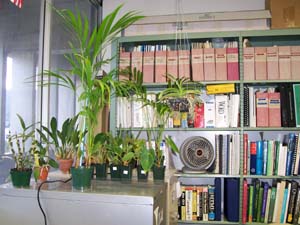
A variety of plants growing near a
north facing
office window.
Leave well enough alone. Supplemental lighting is not
always or automatically needed. Some plants do fine on their own.
Ordinary room light is sufficient.
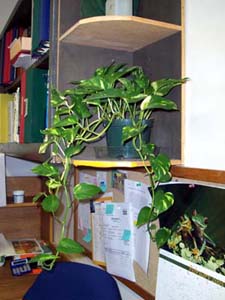
Away from any office window,
this
plant is still growing well.
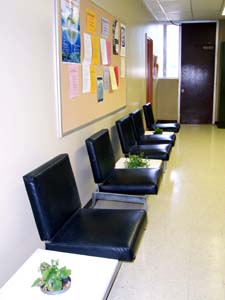
Plants in a waiting area outside elevators.
Matching the plant to the location. If you are looking
for a plant to place in a particular location, try to select
appropriate plants for that specific lighting situation. For example,
Chinese evergreen can tolerate low light intensity and would be
suitable for semi-shady places.
Guide
to selecting houseplants. Anne M.
Streich, University of Nebraska.
SUPPLEMENTAL LIGHTING
MAY BE NEEDED
Getting started. Try to place indoor plants near a
window to get some direct, indirect, or diffused light. If the
lighting is inadequate and your plants need supplemental lighting,
there are two basic kinds of lighting--fluorescent and
incandescent. Other kinds of indoor lighting, such as high
pressure sodium lamps or metal halide lamps, are not be covered in
this web site.
FLUORESCENT
LIGHTING
Advantages
Disadvantages
Light intensity tends to be low so you are limited as to the plants can be grown. Again, try to select plants that can tolerate lower light conditions.
Indoor
plants--cleaning, fertilizing, containers and light
requirements. Debbie Shaughnessy,
Clemson University.
Types. Common types of fluorescent lights are
cool-white and warm-white.
You can use
It is commonly recommended to use a cool-white tube in combination with a warm-white tube. While cool-whites and warm-whites are relatively inexpensive, wide spectrum tubes and high intensity fluorescent tubes are a bit more pricey.
Set up. Fluorescent tubes typically come in 2-foot and
4-foot lengths. The 2-foot length works well if space is
limited.
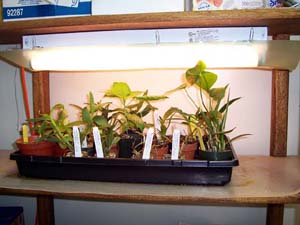
Plants growing under a 2-foot
fluorescent light
fixture attached to a wooden shelf.
A simple set up can be a twin-tube fluorescent shop light fixture
from a local hardware store or garden shop. A fixture that holds two
48-inch 40-watt fluorescent light tubes covers an area approximately
4 feet by 8 inches.
These fixtures come with chains to suspend the fixture over the plants so you can adjust the height according to your plants and raise the fixture as the plants grow taller. Besides being hung from shelving, a fixture can be attached to a shelf (for example, with screws).

Chrysanthemums growing under 4-foot
fluorescent fixtures
and incandescent lights suspended from metal shelving.
An alternative is getting a light cart although this will be more
expensive. It does offer the advantages of mobility (wheels) and
attractiveness. Supplies for caring for the plants can also be stored
on the shelves.
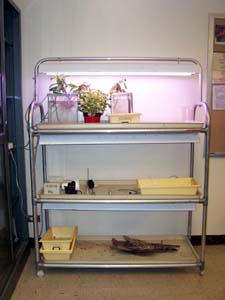
A light cart with a fluorescent
light
fixture suspended above the plants.
INCANDESCENT
LIGHTING
Advantages
Disadvantages
Types. Regular; plant grow lights.
SIDE
LIGHTING
Lighting can be provided not only from the top, but also from the sides.
PLASTIC
FILMS
Whatever the light source, you can use reflective plastic sheet (film) to direct more light to your plants. Mylar can be added to room walls to reflect available light. An alternative is white plastic sheet.
Plastic films that diffuse light can also be used.

Plants growing under fluorescent
lights covered
with a plastic film that diffuses light.
LED
LIGHTING
Light emitting diodes (LEDs) are becoming more prevalent as a light
source, for example, in flashlights. However, they are still
relatively expensive for office and home use.
LED
light sources for plant research,
Kevin M. Folta, University of Florida
Links
Supplemental lighting for indoor plants. DIY Network.
Guide to a green thumb. Heidi Bornhorst, Honolulu Advertiser.